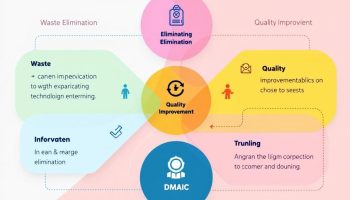
Supply chain resilience examples like Toyota’s multi-sourcing, P&G’s control tower system, Cisco’s strategic buffer inventory, Unilever’s supplier capacity building, Walmart’s blockchain traceability, and 3M’s localized production networks demonstrate crucial adaptation strategies for modern businesses. These approaches show how organizations can transform vulnerability into operational strength through strategic diversification, enhanced visibility, and innovative technology implementation.
Why Supply Chain Resilience Matters for Business Success
Supply chain resilience examples from industry leaders offer essential blueprints for organizations operating in today’s **volatile** business environment. These strategies—from Toyota’s geographic diversification to Walmart’s blockchain implementation—directly impact bottom-line performance by minimizing disruption costs, maintaining service levels, and preserving customer trust during crises. The business value can be measured: companies implementing resilience strategies experience:
- 60% faster recovery times
- 40% fewer supplier-related disruptions
- dramatic improvements in traceability (from days to seconds)
For modern enterprises, these approaches aren’t optional additions but necessary foundations for competitive survival in a marketplace where disruption has become standard. Research shows that supply chain resilience correlates strongly with overall business performance during disruptive events.
You’ll find that companies with resilient supply chains recover faster from setbacks, maintain market share during industry-wide challenges, and can quickly adapt to changing customer demands. These capabilities translate directly into financial performance and brand reputation advantages.
Companies with resilient supply chains not only recover 60% faster from disruptions but also maintain a market advantage by reducing supplier-related disruptions by 40%.
Explore 6 Powerful Supply Chain Resilience Examples: Learn How These Strategies Mitigate Disruptions
In today’s rapidly changing business landscape, supply chain resilience has become a critical focus for organizations aiming to maintain operational continuity. The following examples highlight six companies that have successfully implemented innovative strategies to enhance their supply chain robustness. From Toyota’s comprehensive multi-sourcing strategies to Walmart’s cutting-edge blockchain traceability, each case offers valuable insights into the methods employed to mitigate risks and respond to disruptions effectively.
By exploring these strategies, businesses can identify best practices and learn how to strengthen their own supply chains, ultimately improving agility and responsiveness in a volatile market. Dive into these real-world examples to uncover actionable lessons that can transform your supply chain management.
“`html
1. Toyota’s Multi-Sourcing Strategy
Toyota Motor Corporation provides one of the strongest supply chain resilience examples with its comprehensive multi-sourcing approach. Following the devastating 2011 Fukushima disaster, Toyota redesigned its supplier network by diversifying across different geographic regions. This strategic shift helped the company build a more resilient supply chain that could withstand regional disruptions. By implementing this approach, Toyota reduced its vulnerability to localized disasters by 60%, allowing production to continue despite disruptions in specific areas. The company also managed to cut recovery time from several months to just weeks, demonstrating how effective risk response strategies can transform operational resilience.
“`
2. Procter & Gamble’s Control Tower Visibility
Procter & Gamble demonstrates exceptional supply chain resilience through its advanced control tower system, which serves as a central command center for monitoring operations. This sophisticated technology provides real-time visibility across more than 200 manufacturing facilities and thousands of suppliers, creating a comprehensive view of the entire supply network.
The control tower enables P&G to track inventory movements, production schedules, and transportation activities simultaneously. By implementing this strategic dashboard approach, P&G’s supply chain managers can identify potential disruptions before they cascade into larger problems. The system uses predictive analytics to forecast potential bottlenecks and automatically suggests mitigation strategies.
Results have been impressive, with P&G achieving a 30% reduction in supply chain disruptions across its global operations. Perhaps most valuable is the system’s early warning capability, allowing teams to anticipate potential issues 3-5 days earlier than before implementation. This critical time advantage enables P&G to implement effective risk response planning and adjust operations accordingly.
The control tower also facilitates better coordination between departments, ensuring that manufacturing, procurement, and logistics teams can collaborate effectively when responding to unexpected events.
Expert Insight: To enhance supply chain resilience, implement a control tower system for real-time visibility across operations. This approach identifies potential disruptions early, allowing for proactive mitigation and effective coordination among departments. Ultimately, leveraging predictive analytics can significantly reduce disruptions and improve overall operational efficiency.
3. Cisco’s Strategic Buffer Inventory
Cisco Systems offers a compelling supply chain resilience example through their strategic buffer inventory approach. When semiconductor shortages created industry-wide disruptions, Cisco maintained exceptional 99.2% service levels while competitors struggled with significant delays. Their strategy involved carefully identifying critical components prone to supply chain disruptions and maintaining strategic inventory buffers for these items.
What made Cisco’s approach particularly effective was their use of advanced analytics to optimize inventory placement throughout their global network. Rather than simply increasing inventory across the board—which would have driven up costs dramatically—they used data analytics tools to determine precisely where buffers would provide maximum resilience with minimal investment.
The company complemented this strategy with simulation modeling to test various disruption scenarios, ensuring their buffer strategy could withstand different types of supply chain shocks. Their approach demonstrates that effective supply chain resilience doesn’t necessarily require excessive inventory costs, but rather strategic placement based on risk assessment and optimization.
Expert Insight: Leverage advanced analytics and simulation modeling to strategically maintain buffer inventories in your supply chain. By identifying critical components and optimizing inventory placement, you can achieve resilience and high service levels without incurring excessive costs. Effectively assess risks to minimize disruptions and enhance operational efficiency.
4. Unilever’s Supplier Capacity Building Program
Building supply chain resilience requires strategic investment in your supplier ecosystem, as demonstrated by Unilever’s comprehensive approach. The consumer goods giant recognized that a resilient supply chain depends on the strength of its weakest links, prompting them to develop a supplier capacity building program that spans over 1,500 key suppliers worldwide.
Unilever’s strategy focuses on three critical areas to enhance supply chain resilience. First, they provide specialized training programs that help suppliers implement best practices in operations, quality management, and business continuity planning. Second, they offer financial support mechanisms, including favorable payment terms and investment assistance for critical infrastructure upgrades. Third, they provide digitalization assistance, helping suppliers implement technologies that improve visibility and responsiveness.
The results have been remarkable for Unilever’s supply chain resilience. They’ve achieved a 40% reduction in supplier-related disruptions compared to pre-program levels. Additionally, their supplier network demonstrates a 22% improvement in responsiveness during peak demand periods, allowing the company to execute risk response plans more effectively when challenges arise.
By investing in supplier capabilities rather than merely demanding performance, Unilever has created a more adaptable and robust supply network that benefits both the company and its partners during disruptions.
Expert Insight: Invest in your supplier ecosystem to build supply chain resilience, as evidenced by Unilever’s capacity building program. Focus on specialized training, financial support, and digitalization assistance to strengthen partnerships. This approach not only enhances supplier performance but also improves overall responsiveness and adaptability during disruptions.
5. Walmart’s Blockchain Traceability
Walmart has revolutionized supply chain resilience examples with its innovative blockchain implementation. The retail giant integrated this technology to create complete transparency across its extensive food supply network. By digitizing product journeys, Walmart enhanced its ability to respond to disruptions with unprecedented speed.
The impact on supply chain resilience was remarkable. Product tracing time dropped dramatically from 7 days to just 2.2 seconds, allowing for immediate identification of sources when quality issues arise. This data-driven supply chain optimization enables Walmart to pinpoint contamination sources during food safety concerns instantly, rather than conducting lengthy investigations.
When food recalls become necessary, Walmart can now:
- Target only affected products instead of entire categories
- Minimize food waste from unnecessary disposal
- Reduce financial losses from over-cautious recalls
- Maintain consumer trust through rapid, precise responses
This blockchain solution also improves Walmart’s everyday operations by providing complete product lifecycle visibility, from farm origins to store shelves, strengthening their risk response strategy across the entire supply chain.
Expert Insight: Leverage blockchain technology to enhance supply chain transparency and resilience by digitizing product journeys. This enables rapid response to quality issues, minimizes waste and losses, and maintains consumer trust. Prioritize traceability to strengthen risk response and optimize overall supply chain management effectively.
6. 3M’s Localized Production Network: A Blueprint for Supply Chain Resilience
3M’s approach to supply chain resilience exemplifies how geographic diversification can create robust operations. The company strategically established regional manufacturing hubs capable of producing similar products across different locations, reducing reliance on centralized production facilities. This distributed manufacturing network has become a cornerstone of 3M’s supply chain resilience strategy.
During the COVID-19 pandemic, 3M demonstrated the effectiveness of this approach by quickly redirecting production capacity at various facilities to meet surging demand for personal protective equipment. Their manufacturing network allowed them to respond rapidly to crisis conditions while maintaining production of other essential products.
The benefits of 3M’s localized production strategy include:
- Reduced transportation costs and carbon footprint
- Decreased vulnerability to regional disruptions
- Faster response times to local market demands
- Enhanced ability to navigate trade barriers and regulatory changes
By implementing this decentralized manufacturing approach, 3M created a flexible network that could adapt to supply chain challenges while maintaining consistent product quality across regions.
Supply chain resilience examples from industry leaders like Toyota, Procter & Gamble, Cisco, Unilever, Walmart, and 3M demonstrate how strategic approaches to diversification, visibility, inventory management, supplier relationships, traceability, and localized production can transform operational resilience. These companies have successfully implemented multi-sourcing strategies, control tower systems, strategic buffer inventory, supplier capacity building, blockchain traceability, and decentralized manufacturing networks to withstand disruptions while maintaining business continuity.
For business and enterprise users, these supply chain resilience examples from Toyota, P&G, Cisco, Unilever, Walmart, and 3M are not merely theoretical concepts but essential business practices that determine competitive advantage in today’s volatile global markets. Organizations implementing these strategies have demonstrated measurable benefits, including:
- Reduced recovery times
- Improved service levels
- Decreased disruption frequency
- Enhanced supplier responsiveness
- Faster problem identification
- Greater operational flexibility
In an era where global disruptions have become commonplace—from pandemic impacts to geopolitical tensions and climate events—these approaches provide a blueprint for creating adaptive supply networks that can respond effectively to challenges while maintaining operational efficiency and customer satisfaction.
Conclusion
Toyota, P&G, Cisco, Unilever, Walmart, and 3M demonstrate that effective supply chain resilience requires strategic approaches to diversification, visibility, inventory management, supplier relationships, traceability, and localized production. These companies have successfully implemented multi-sourcing strategies, control towers, strategic buffers, capacity building programs, blockchain technology, and decentralized networks that deliver measurable results. Their examples prove that resilience isn’t just about risk mitigation—it’s a competitive advantage that enables organizations to maintain continuity while competitors struggle during disruptions.
Actionable Steps
- Implement a multi-sourcing strategy by diversifying suppliers across different geographic regions to reduce vulnerability to localized disruptions
- Develop a control tower system that provides real-time visibility across operations to identify potential issues before they escalate
- Use advanced analytics to strategically place inventory buffers for critical components rather than increasing inventory across the board
- Invest in supplier capacity building through specialized training, financial support, and digitalization assistance
- Consider blockchain technology for critical supply chains to improve traceability and enable rapid response to quality issues






